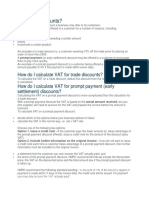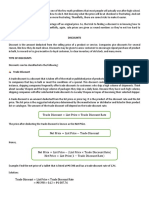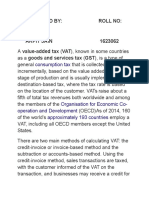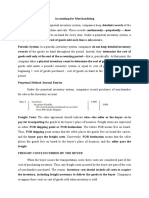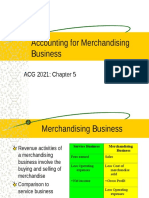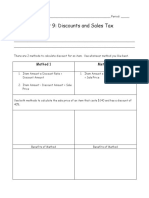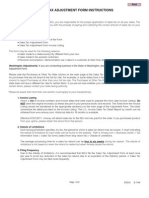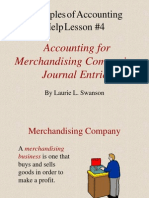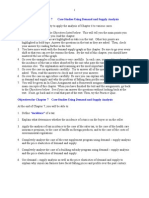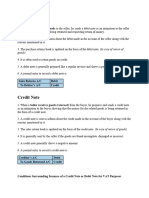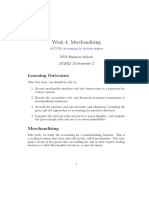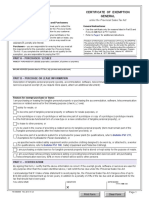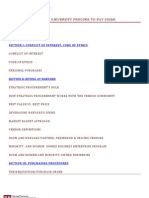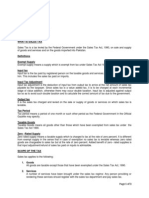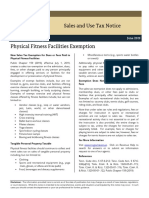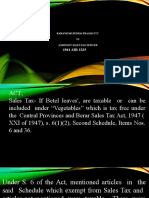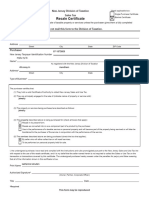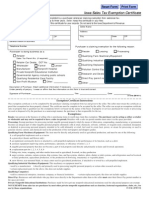Texas Comptroller Memo, STAR 200904303L (Apr. 24, 2009)
Uploaded by
Paul MastersTexas Comptroller Memo, STAR 200904303L (Apr. 24, 2009)
Uploaded by
Paul MastersTexas Comptroller of Public Accounts
STAR System
200904303L
MEMORANDUM TO: Tax Policy FROM: Jody Frierson DATE: April 24, 2009 RE: Discounts, Coupons, Free Meals, Buy One Get One Free Coupons, and Rebates Below is information on price reductions. Retailers should remember to charge tax only on the final sales price of a taxable item. The final sales price is the total after all discounts, coupons, free offers and all other price reductions have been subtracted. Tax is due only on the amount actually charged the customer. Discounts Cash discounts are offers to customers that reduce an item's sales price. For example, a retailer may offer a customer a 10 percent discount on all purchases. If the customer buys a dress marked at $150, the discounted price becomes $135. Tax is due on the final discounted sales price of $135. Coupons There are two types of coupons that are equivalents of a cash discount: manufacturer's coupons, which reimburse the retailer the coupon's face value plus a handling fee; and in-store coupons, for which there is no retailer reimbursement. Both types of coupons are handled the same. Because the coupons reduce the price charged to the customer, the retailer should collect tax on the net price, after subtracting the value of the coupon. Some retailers offer to double or triple the face value of manufacturers' coupons. In these cases, tax is due on the final reduced sales price, after subtracting the doubled or tripled face value of the coupon. Free Meals and Buy One, Get One Free Offers A restaurant that sells two meals for the price of one should collect sales tax only on the amount charged the customer. The customer pays no tax on the free meal. For more information on charging sales tax in restaurants, see our publication 94-117, Restaurants and the Texas Sales Tax. Rebates A mail-in manufacturer's rebate that is given after the sale does not reduce the sales price a retailer charges the customer. For example, a $250 camera comes with a $50 manufacturer's rebate offer. A customer buys the camera for $250 then mails in proof of purchase and other documentation to receive the $50 rebate. The retailer must collect tax on the $250 sales price of the camera, the amount charged the customer. A manufacturer's rebate that is deducted at checkout is treated as a cash discount. If a $250 camera has a $50 rebate taken at the time of sale, tax is
due on the final selling price of $200. A mail-in rebate from the seller may be used to reduce the taxable sales price of the item. The seller should refund the sales tax that was collected on the part of the sales price that was rebated back to the customer. For example, a consumer buys software for $150 with an available mail-in rebate of $25. When the customer returns the rebate to the store and the retailer rebates the $25, it should also rebate tax on the $25. In this case, the tax would equal $2.06 (i.e. $25 x .0825 state, city and transit tax), for a total rebate of $27.06. Or, the sellers rebate can specifically state that it is a tax included rebate. By doing so, the seller can rebate a total of $25 to the customer (i.e. $25 / 1.0825 = $23.09 rebate + $1.91 = $25).
ACCESSION NUMBER: 200904303L SUPERSEDED: N DOCUMENT TYPE: L DATE: 04/24/2009 TAX TYPE: SALES
You might also like
- 2024 Freedom Month Sales Tax Holiday - External FAQs - Sales and Use Tax Dealers100% (1)2024 Freedom Month Sales Tax Holiday - External FAQs - Sales and Use Tax Dealers8 pages
- Discounts: Types of Discounts Calculation of Discounts Practice Questions Answer Bank100% (1)Discounts: Types of Discounts Calculation of Discounts Practice Questions Answer Bank6 pages
- BMTH210 - AK - Worksheet 7 - Discounts - Fall 2022 2023No ratings yetBMTH210 - AK - Worksheet 7 - Discounts - Fall 2022 20239 pages
- Chapter Five: Special Issues For MerchantsNo ratings yetChapter Five: Special Issues For Merchants26 pages
- Discounts: Trade Discount List Price × Trade Discount RateNo ratings yetDiscounts: Trade Discount List Price × Trade Discount Rate5 pages
- Buying and Selling - Trade and Cash DiscountsNo ratings yetBuying and Selling - Trade and Cash Discounts30 pages
- Accounting For Merchandising Operations: Key Terms and Concepts To KnowNo ratings yetAccounting For Merchandising Operations: Key Terms and Concepts To Know25 pages
- 0 Accounting For Merchandising BusinessNo ratings yet0 Accounting For Merchandising Business114 pages
- Auto Informer: What's The Deal With Dealer Fees?No ratings yetAuto Informer: What's The Deal With Dealer Fees?3 pages
- Accounting For Merchandising Business ACG 2021 Module 550% (2)Accounting For Merchandising Business ACG 2021 Module 545 pages
- Packet 9: Discounts and Sales Tax: Method 1 Method 2No ratings yetPacket 9: Discounts and Sales Tax: Method 1 Method 29 pages
- Senior High School Department: Quarter 3 - Module 9: Merchandising Concern (Part 2)No ratings yetSenior High School Department: Quarter 3 - Module 9: Merchandising Concern (Part 2)18 pages
- Value Added Tax Definition Examples InvestopediaNo ratings yetValue Added Tax Definition Examples Investopedia7 pages
- Ops Amw FRM D en SalesTaxAdjustmentForm AllStatesExceptWA2013No ratings yetOps Amw FRM D en SalesTaxAdjustmentForm AllStatesExceptWA20136 pages
- BM Lesson05 Buying and Selling DiscountsNo ratings yetBM Lesson05 Buying and Selling Discounts9 pages
- Buying and Selling - Commissions and OverridesNo ratings yetBuying and Selling - Commissions and Overrides32 pages
- MIDERTM September 14, 2024 - Accounting For Merchandising BussinessNo ratings yetMIDERTM September 14, 2024 - Accounting For Merchandising Bussiness9 pages
- EBay Charges How Much Does It Require To Sell On EBayNo ratings yetEBay Charges How Much Does It Require To Sell On EBay3 pages
- Accounting Activity of Merchandising OperationsNo ratings yetAccounting Activity of Merchandising Operations20 pages
- Indiana DOR, Letter of Findings Number 04-2010069 (Nov. 4, 2011)No ratings yetIndiana DOR, Letter of Findings Number 04-2010069 (Nov. 4, 2011)2 pages
- Columbus City School Dist. Bd. of Edn. v. Testa, Slip Opinion No. 2011-Ohio-5534No ratings yetColumbus City School Dist. Bd. of Edn. v. Testa, Slip Opinion No. 2011-Ohio-553413 pages
- Colo. DOR, FYI Pub. Sales 62: Guidelines For Determining When To Collect State-Collected Local Sales Tax (Oct. 2011)No ratings yetColo. DOR, FYI Pub. Sales 62: Guidelines For Determining When To Collect State-Collected Local Sales Tax (Oct. 2011)3 pages
- In The United States Bankruptcy Court For The District of DelawareNo ratings yetIn The United States Bankruptcy Court For The District of Delaware28 pages
- Arizona DOR Decision, Case 201000178-S (Aug. 1, 2011)No ratings yetArizona DOR Decision, Case 201000178-S (Aug. 1, 2011)10 pages
- Indiana DOR Letter of Findings: 04-20100641 09-20100639 10-20100640 (Oct. 26, 2011)No ratings yetIndiana DOR Letter of Findings: 04-20100641 09-20100639 10-20100640 (Oct. 26, 2011)10 pages
- Ohio Tax Information Release ST 2007-04 (Revised Oct. 1, 2011)No ratings yetOhio Tax Information Release ST 2007-04 (Revised Oct. 1, 2011)3 pages
- Texas Taxpayer Student Fairness Coalition FilingNo ratings yetTexas Taxpayer Student Fairness Coalition Filing17 pages
- Illinois General Information Letter On Software Maintenance, ST 11-0070-GIL (Aug. 29, 2011)No ratings yetIllinois General Information Letter On Software Maintenance, ST 11-0070-GIL (Aug. 29, 2011)4 pages
- 1) Cebu Portland Cement v. CTA, L-29059, 15 Dec 1987, 156 SCRA 535 (Lifeblood of The Government)No ratings yet1) Cebu Portland Cement v. CTA, L-29059, 15 Dec 1987, 156 SCRA 535 (Lifeblood of The Government)9 pages
- OPO 230000302880 Agilent Spectrometer signed (1)No ratings yetOPO 230000302880 Agilent Spectrometer signed (1)23 pages
- Resale Certificate: Purchaser InformationNo ratings yetResale Certificate: Purchaser Information2 pages
- Comptroller's List of Taxable/Nontaxable ItemsNo ratings yetComptroller's List of Taxable/Nontaxable Items4 pages
- Learning Guide: Accounts and Budget Support Level IiiNo ratings yetLearning Guide: Accounts and Budget Support Level Iii75 pages
- Retail and Enterprise POS Localization For BrazilNo ratings yetRetail and Enterprise POS Localization For Brazil10 pages
- Sales and Use Tax Notice Physical Fitness Facilities ExemptionNo ratings yetSales and Use Tax Notice Physical Fitness Facilities Exemption1 page
- Sales Tax Comprehensive Question (1) UpdateNo ratings yetSales Tax Comprehensive Question (1) Update10 pages
- (R.A.) No. 7082 To Install, Operate and Maintain ANo ratings yet(R.A.) No. 7082 To Install, Operate and Maintain A5 pages
- PPD 647 - Tax Paper - Cross Border Shopping - RaraNo ratings yetPPD 647 - Tax Paper - Cross Border Shopping - Rara6 pages
- Iowa Sales Tax Exemption Certificate: WWW - Iowa.gov/tax Iowa Department of RevenueNo ratings yetIowa Sales Tax Exemption Certificate: WWW - Iowa.gov/tax Iowa Department of Revenue1 page











